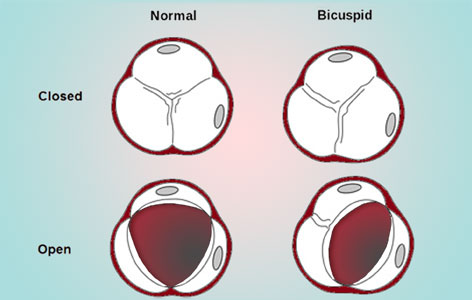Home page Description:
Life-threatening changes to the aorta—the body’s largest artery—are driven by micro-RNA.
Posted On: September 19, 2016

Image Caption:
The aortic valve prevents blood from flowing back into the heart. While most people have valves with three leaves, 1-2% have a bicuspid valve (pictured right).
The heart pumps blood through the arteries to the rest of the body, starting with the largest artery—the aorta. A valve in the heart—the aortic valve—ensures that blood flows in one direction, out of the heart and into the aorta. This valve is normally made up of three leaves, but in a rare cardiac condition called bicuspid aortic valve (BAV), the valve only has two leaves. This condition changes blood flow and can lead to progressive dilation (ie, widening) of the aorta which, if not surgically replaced, can be fatal.
Understanding the mechanisms responsible for this dilation may lead to new treatments to prevent it in high risk patients. In a recent study, TGHRI Senior Scientist Dr. Ren-Ke Li and colleagues collected tissue samples from the aortas of patients with and without BAV who had undergone heart surgery.
The researchers looked at levels of micro-RNAs—small non-coding RNA molecules that regulate gene function in the cell—and found that a group of these molecules, known as miR-17, varied according to the degree of dilation observed in patients. This micro-RNA group plays a role in regulating matrix metalloproteinases (MMP), enzymes that can break down the connecting material between cells and that are important for altering the structure of the aorta associated with dilation.
An increase in miR-17 and MMP activity may be an early hallmark of dangerous changes to the structure of the aorta in BAV. miR-17 levels were highest in the less-dilated sections from patients with BAV, suggesting that this normal-looking tissue was in the early stages of the disease. “Decreasing miR-17 expression during the early stages of dilation may prevent further progression, and represents a potential therapeutic target,” says Dr. Li.
This work was supported by The Larry and Cookie Rossy Family Foundation, the Heart and Stroke Foundation of Ontario and the Toronto General & Western Hospital Foundation. Dr. TM Yau holds the Angelo and Lorenza DeGasperis Chair in Cardiovascular Surgery Research. Dr. R-K Li holds the Tier 1 Canada Research Chair in Cardiac Regeneration. Image credit: creative commons license, Cardionetworks via Wikimedia Commons.
Progressive aortic dilation Is regulated by miR-17-associated miRNAs. Wu J, Song HF, Li SH, Guo J, Tsang K, Tumiati L, Butany J, Yau TM, Ouzounian M, Fu S, David TE, Weisel RD, Li RK. Journal of the American College of Cardiology. doi: 10.1016/j.jacc.2016.04.027. 2016 Jun 28. [Pubmed abstract]
Understanding the mechanisms responsible for this dilation may lead to new treatments to prevent it in high risk patients. In a recent study, TGHRI Senior Scientist Dr. Ren-Ke Li and colleagues collected tissue samples from the aortas of patients with and without BAV who had undergone heart surgery.
The researchers looked at levels of micro-RNAs—small non-coding RNA molecules that regulate gene function in the cell—and found that a group of these molecules, known as miR-17, varied according to the degree of dilation observed in patients. This micro-RNA group plays a role in regulating matrix metalloproteinases (MMP), enzymes that can break down the connecting material between cells and that are important for altering the structure of the aorta associated with dilation.
An increase in miR-17 and MMP activity may be an early hallmark of dangerous changes to the structure of the aorta in BAV. miR-17 levels were highest in the less-dilated sections from patients with BAV, suggesting that this normal-looking tissue was in the early stages of the disease. “Decreasing miR-17 expression during the early stages of dilation may prevent further progression, and represents a potential therapeutic target,” says Dr. Li.
This work was supported by The Larry and Cookie Rossy Family Foundation, the Heart and Stroke Foundation of Ontario and the Toronto General & Western Hospital Foundation. Dr. TM Yau holds the Angelo and Lorenza DeGasperis Chair in Cardiovascular Surgery Research. Dr. R-K Li holds the Tier 1 Canada Research Chair in Cardiac Regeneration. Image credit: creative commons license, Cardionetworks via Wikimedia Commons.
Progressive aortic dilation Is regulated by miR-17-associated miRNAs. Wu J, Song HF, Li SH, Guo J, Tsang K, Tumiati L, Butany J, Yau TM, Ouzounian M, Fu S, David TE, Weisel RD, Li RK. Journal of the American College of Cardiology. doi: 10.1016/j.jacc.2016.04.027. 2016 Jun 28. [Pubmed abstract]




